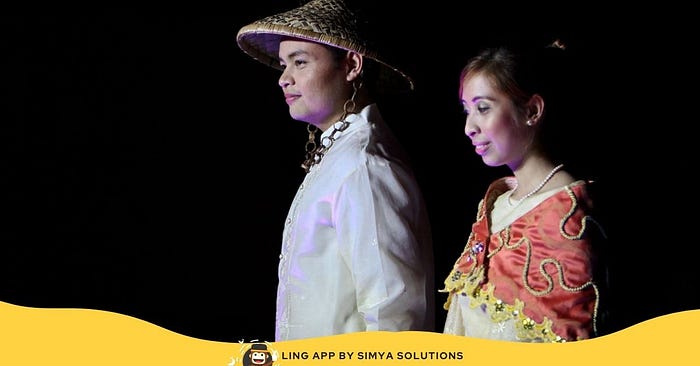Traditional Filipino Clothing: 2 Best Attires
Original blog post: https://ling-app.com/fil/traditional-filipino-clothing/

Have you ever wondered what the Filipino people mean when they say barong Tagalog or Maria Clara dress? In today’s post, we will walk you through the Tagalog words for traditional Filipino clothing for special occasions and what makes it truly different from other outfits from Asia. After all, every country has a unique type of costume which can reflect more about their cultures and beliefs. Since the Philippines has a conservative society, you can expect that style is very formal. Let’s find out more about that in this post!
When it comes to fashion, every country is different as most of what the people wear on a daily basis are greatly influenced by society and the circumstances around them. It is only natural to see that the national costume may include long sleeves, fur, wool, and thick coats in Western countries as it serves as an added layer of protection against the cold. For countries in Southeast Asia, the historical account states that the craze is all about silk with bright colors and is usually partnered with jewels of all sorts. Since Asia enjoys an abundance of natural stones, jewelry is used to define social status.
In the case of the Philippines, traditional clothing is much more different. In fact, the country is made up of so many islands that it is impossible to determine what constitutes a “national attire truly.” This is because every tribe and island somehow has created their own version of clothing which best fits their way of living. In the cities, some were able to wear clothes and skirts made of pina fabric, while Filipinos from provincial places traditionally wear wraparound cloths which can be worn in different ways. For those living near trade routes, there are those who wore Camisa de Chino (Chinese collarless shirt) every day.
In terms of accessories, the Filipinos also boast different ones like the salakot (a sustainable version of a hat usually used by farmers), bakya (clogs or wooden shoes), paynéta (ornamental comb which can also be worn with a formal dress, and the classic abaniko (traditional hand-held fan). In provinces, there are also Filipino men who used to wear bahag during pre-colonial times. But perhaps you are wondering, what exactly is the outfit that is considered the national attire? Let’s learn below.
What Is The Traditional Filipino Clothing?
Traditional Filipino clothing is truly different than what other countries have to offer. Due to the tropical climate, most of what the Filipinos wore are made of thin fabric in order to make it comfortable despite the heat. In addition, they made use of local fabrics for crafting blouses, butterfly sleeves, skirts, and outerwear. Inside, they usually wear rough cotton cloth. Another major characteristic of traditional clothing is that the female must always wear a baro (Filipino blouse) and/or alampay shawl as showing skin is deemed inappropriate.
Barong Tagalog

For men’s clothing, the use of Barong Tagalog is important as it exemplifies craftsmanship and the beauty of our natural resources. It is very popular even to this day since it makes use of textiles that are truly very Filipino, like the piña or abacá cloth. Today, this costume also uses different types of cloths like silk, polyester, and ramie. To complete the look, it is paired with black trousers and dress shoes.
Baro’t Saya Or Maria Clara Dress

Before the Spanish era, there are historical accounts that suggest that Filipinos also wore lihin-lihin, which refers to tunics and blouses similar to a robe. During the Spanish colonization and the spread of Christianity, the locals started imitating the conservative fashion, and this became the start of the common Camisa. The Camisa is usually made of translucent fabric and is best known for its cuff-like sleeves, which are often called “angel wings”. In addition to the Camisa, the females also used to wear a Panuelo, which is a fabric for covering the neck to show modesty.
To complete the look for the female Filipinos, they usually wear a wrap-around skirt called Tapis made of madras cloth. The Tapis is the inner of the Saya (the outer skirt), and it is worn since the Saya usually uses a cloth that is a bit thinner. This type of clothing is now known as the Maria Clara dress.
Wrapping Up
As we reach this part of the post, we hope that you were able to learn all there is to know about the traditional attire or kasuotan in the Philippines. If you enjoyed this post and figured that you would love to learn more about the Pearl Of The Orient Seas and its language, then we highly recommend that you do not miss out on our previous language posts like the regions and the common religions existing in the country.
But if you feel that you are someone who is more interested in learning about the Tagalog language and speaking it like a pro in no time, then using our most recommended app is the best way to go. This app is just the best one out there as it is filled with tons of amazing content and lessons that are guaranteed to aid you in your language learning journey. Read more about this in the next section to discover what it is all about.
Learn A Foreign Language With The Ling App

When it comes to mastering a foreign language, nothing beats the quality of the Ling App by Simya Solutions. By simply making use of the app, you can instantly learn Tagalog and 60+ other languages. And when we say “learn” we literally mean that the Ling App comes equipped with lots of lessons, quizzes, and games that are all created by real native speakers, language professionals, and educators. With the combination of such a team, we can ensure that you can step into the unknown and converse without any worries.
So, what are you waiting for? Download it today and start learning in the right way. If you are still unsure whether this is the best app for you, click here to see an epic review of its features.
